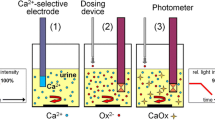Abstract
The possible significance of low molecular weight inhibitors (Mg, citrate and pyrophosphate) in the prevention of calcium oxalate urolithiasis has been emphasized1. Estimation of total 24 h excretion of urinary inhibitors in stone-formers (SF) will not reveal any circadian fluctuations. However, measurements of 3-hourly urine samples collected over a 24 h span should give a better picture of their circadian rhythmicity, which may help to expose any urinary biological abnormalities present therein. Therefore, the circadian rhythm of the 3 h excretion of Mg, citrate and pyrophosphate, and urinary inhibitory activity towards calcium oxalate monohydrate (COM) crystallization in SF and healthy subjects (N), were investigated.
Access this chapter
Tax calculation will be finalised at checkout
Purchases are for personal use only
Similar content being viewed by others
References
K Kohri, J Garside and NJ Blacklock, The role of magnesium in calcium oxalate urolithiasis, Brit J Urol 61: 107 (1988).
D Wangoo, SK Thind, GS Gupta and R Nath, Chronobiology of urinary citrate amongst stone-formers and healthy males from North-Western India, Urol Res 19: 203 (1991).
RCG Russel and A Hodgkinson, Urinary excretion of inorganic pyrophosphate by normal subjects and patients with renal calculus, Clin Sci 31: 51 (1986).
FL Coe, HC Margolis, LH Deutsch and AL Strauss, Urinary macromolecular crystal growth inhibitors in calcium nephrolithiasis, Mineral Electrolyte Metab 3: 268 (1980).
Y Touitou, C Touitou, G Charransol et al, Alterations in circadian rhythmicity in calcium oxalate renal stone formers. Int J Chronbiol 8: 175 (1983).
N Kinoshita, Diurnal variation in plasma oxalate concentration and oxalate clearance in calcium oxalate stone formers with special Reference to the effect of oxalate loading, Hinyakika Kiya 33: 1331 (1987).
MK Li, DK Shum and S Choi, Detection of crystallization in inhibitory activity of whole urine with a gel model, Urol Res 15: 75 (1987).
Author information
Authors and Affiliations
Editor information
Editors and Affiliations
Rights and permissions
Copyright information
© 1994 Springer Science+Business Media New York
About this chapter
Cite this chapter
Wangoo, D., Rattan, V., Thind, S.K., Gupta, G.S., Nath, R. (1994). Circadian Rhythmometric Studies on the Low Molecular Weight Urinary Inhibitors of Calcium Oxalate Urolithiasis. In: Ryall, R., Bais, R., Marshall, V.R., Rofe, A.M., Smith, L.H., Walker, V.R. (eds) Urolithiasis 2. Springer, Boston, MA. https://doi.org/10.1007/978-1-4615-2556-1_139
Download citation
DOI: https://doi.org/10.1007/978-1-4615-2556-1_139
Publisher Name: Springer, Boston, MA
Print ISBN: 978-1-4613-6091-9
Online ISBN: 978-1-4615-2556-1
eBook Packages: Springer Book Archive




